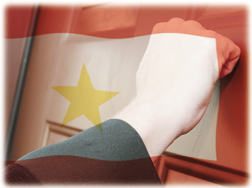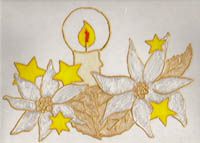
The Blue Star Mothers of America, Inc. and the United States Department of Defense have worked together to establish the Blue to Gold Program through which Blue Star Mothers can offer comfort and assistance at the time of a military death.
Working through Casualty Assistance Officers and/or Funeral Home Directors, the Blue Star Mothers within the program follow strick guidelines to ensure family privacy, security, and respect.
We attend memorials, wakes, funerals, burials, or will meet with family members at a time of their choice. We bring Gold Star Banners for mothers, fathers, and spouses of the fallen. These Gold Star Banners have the name of the fallen on them and also the branch of the service they were in. The Casualty Assistance Officer or the Funeral Home Director will let us know the family's choice as to when they would like to see us and when they would like to have their banner(s) presented to them. Often we present at the funeral when others are also giving other honors. Often prior to or during the wake while the family is receiving people. Other times we are asked to present privately.
The Connecticut Blue Star Mothers - CT Chapter One also offers to our Gold Star families various personal items of comfort and care through this program. Many we make ourselves (prayer shawls, memory books, cross stitch samplers, prayer cloths, etc.) and some come from others (oil portraits of your loved one, portraits on wood, Gold Star pins, etc.). All are given at no cost to the family to show honor and appreciation for the tremendous sacrifices they have made. If you are a Gold Star Family and have not received these items, please contact us.
The Blue to Gold Program is an on going program. We seek to bring comfort at the time of loss and we also seek to continue to assist the families in any way that we can. All Gold Star Family members are welcome and will be given honorary membership to the Connecticut Blue Star Mothers Chapter.
Our Chapter began to form in May of 2006 and, thus we were not here at the time many of our CT military were lost in the war on terror. If we can assist you at this time or would like to have any of the items we can offer, please let us know. If you would like to join with us to be a part of our family that cares for the troops and veterans, we welcome you.
For any questions concerning the Blue to Gold Program in Connecticut, please contact our Chapter's Blue to Gold Liaison, Rev. Lin McGee at:
Email: Blue.Star.Mothers.Rev.Lin.McGee@gmail.com
Phone: 860-379-1298
Address: 111 Marshall St. Winsted, CT 06098

By Heather Graham
Sentinel Living Editor
It is perhaps the most difficult job in the Army.
It is also one of the most important jobs in the Army and another way the Army family takes care of its own.
Casualty notification officers are given the daunting task of knocking on a family’s door and delivering news that will change the lives of a Soldier’s family members.
“We are all one big family. That is all part of taking care of the family,” Sgt. 1st Class Latisha Brown, who works with the wounded and retiree cell at the Casualty Assistance Center, said. “You want to be able to notify the family before anyone else does because they are part of the Army family. We are taking care of our own.”
When a Soldier dies there are a minimum of four categories involved in assisting the family of the deceased Soldier.
The notification team, comprised of the casualty notification officer and a chaplain, visits the Soldier’s primary next-of-kin and delivers news of the Soldier’s death.
The next day, the casualty assistance officer comes to see the family to explain the paperwork and the benefits and entitlements the family may receive.
The casualty assistance officer continues to work with the family until all benefits and entitlements are started, sometimes up to 180 days.
An escort accompanies the remains of the deceased home.
The summary court officer ties up the affairs of the deceased Soldier and clears the Soldier from the installation.
When a Soldier is killed or dies in-theater, the body is flown to Dover, Del., where the mortuary services there prepare the remains and a final positive identification of the remains is made. The escort, sent by Fort Hood, meets the Soldier there and accompanies the body on its final journey home. The rank of the escort is dependent upon the rank of the deceased.
Casualty notifications are statutory and governed by law, not regulatory in that there is a set way of doing things, according to Lee Price, chief, Fort Hood’s Casualty Assistance Center.
Although not as difficult as receiving the news, the bearer of a casualty notification faces a hard and stressful task.
“Regardless of what you do in the Army, there is no more difficult job in the world than being a CNO,” Price said. “Soldiers, by virtue of what they do, are immortal. So the Soldiers making the notifications, 90 percent of them are saying, ‘Ok, it didn’t happen to me but I’ve got to take care of my battle buddy, my fallen comrade.’”
Price told of Soldiers shaking so hard during notifications, they could not stop knocking on the door and of others who broke down crying during the training.
Soldiers must be very diplomatic and retain their objective of getting the family to support agencies, Price said. “They must have empathy with the family without becoming part of the family,” he added.
Soldiers are picked for this task, a task no one would want to volunteer to carry out. The units select the Soldiers for the casualty assistance training.
Training is conducted on-post at the Casualty Assistance Center.
“The CAC has turned away Soldiers when we feel it would be detrimental to the Soldier or a family,” Price said.
Casualty notification officers at Fort Hood go through one week, 40 hours of training which includes videos, manuals, role play exercises and Web-based resources, Price said.
While the Army has initiated standardized training effective Nov. 1 for casualty notifications, the Casualty Assistance Center has yet to be given the instructions.
Fortunately, Fort Hood is already known for the above-the-bar-standards and excellence in casualty assistance.
According to Price, a large part of the standardized training will reflect what is already used in common practice at Fort Hood.
“A lot of stuff the (Department of the Army) has done is a mirror of what we have done here at Fort Hood (regarding casualty notifications),” Price said.
There are two types of notifications: Those done over the phone and those delivered in person. Whenever possible, the notifications are conducted by someone in the Soldier’s unit.
For injured Soldiers, regardless of the extent of the injuries or illness, notification is made by telephone to the primary next-of-kin. The notification officer follows a script and gives the pertinent information such as the Soldiers condition from not seriously ill or injured to seriously to very seriously as well as some general information regarding the circumstances.
This phone call must be made within two hours of the CAC receiving the report of the injured or ill Soldier. If contact with a family cannot be made, the local casualty office informs the DA that a notification has not been made and why. Price said. “Then, the DA officials tell us to keep trying or they take over to complete the notification,” he said.
The caller does not go into great detail on the incident or the injuries. This is to protect the family. “There is some sensitivity that has to go with it,” Price said.
At the family’s request, they can receive the casualty report which goes into depth of the incident and injury.
A phone number is also given that the family can call 24 hours a day, seven days a week for more information.
That initial telephone call is then followed by a call from someone at the Department of the Army level within 48 hours. This call will provide an update on the Soldier’s condition and afford the family the opportunity to ask more questions.
The unit usually contacts and keeps in touch with the family as well, Price said.
Family members are reminded not to make travel arrangements without DA approval. Travel and Transportation Orders are generated by the DA and are only issued at the hospital commander’s or attending physician’s request. “The DA can move up to three members of a Soldier’s family within 24 hours if the doctors think it will benefit the Soldier,” Price said.
In-person notifications occur when a Soldier dies or is missing. The CAC has four hours from when the office is notified to complete a notification to the family
Notifications are done in-person for all deaths regardless of if they occur in theater or in garrison. Casualty notification officers must be in Class A uniforms for the notification. There are always two Soldiers: the CNO and a chaplain.
Notifications are conducted from 6 a.m.-10 p.m. in the time zone where the primary next-of-kin is located. With DA permission, notifications can be delivered after 10 p.m., Price said, giving the example of a range training accident that occurred at night and the family is awaiting the Soldier’s return.
Rank plays an important role in casualty notification and assistance.
For enlisted Soldiers, the casualty notification and assistance officers must be at minimum a sergeant first class. When notifying an officer’s family, the CNO and CAO must be at minimum, a captain with six years of active service. The families of warrant officers can be handled by CW2-5. For more senior enlisted and commissioned ranks, the rank of the team members should be at least equivalent to that of the servicemember.
“This has to do with similar backgrounds and experiences in Army life,” Price explained. “The duty is hard enough without throwing in extra dynamics.”
Within four hours of the notification, the CAO must contact the family. This prevents the family from making arrangements without being informed of all benefits and entitlements, Price said.
Families of Soldiers declared Duty Status Whereabouts Unknown and Missing in Action are also notified in-person and given the circumstances surrounding the Soldier’s status.
When notifying a family, the CNO follows one of five scripts depending on the situation – positively identified, believed to be/identification not complete, suspected to be, DUSTWYN and Missing.
“The CNO tells the family the circumstance surrounding the incident,” Price said. They speak to the primary next-of-kin alone and help them try to deal with the initial impact of the news.
The family can also be directed to support organizations on-post. “There’s a lot of good support organizations out there,” he added.
The CNO debriefs with the CAO, letting the assistance officer know how the family is doing.
“The CAO needs to know what they are walking into,” Price said.
The CNO and the CAO jobs rarely, if ever, overlap. “We try never to use a CNO as the CAO for the same case,” Price said. “The CNO is the ‘bad guy.’”
The Casualty Assistance Center tries to keep the jobs separate and try to align the support networks to best serve the family.
“We also recommend the company commander and the first sergeant not make the notification,” Price said. “We recommend they come in after and support the family.”
